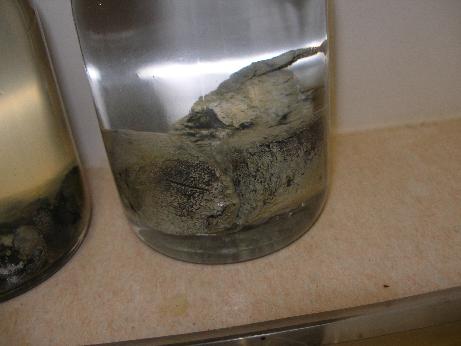The_Davster
A pnictogen
      
Posts: 2861
Registered: 18-11-2003
Member Is Offline
Mood: .
|
|
Removing the superoxide from potassium metal
I came into some rather heavily oxidized potassium metal recently, I am hoping that I can speak to the proff that I am doing research with to let me
seal some in a vaccuum ampoule. But first there is the oxide/superoxide on it. I have of course seen everywhere online that attempting to cut
potassium with a superoxide can cause all sorts of nastiness; explosions, oil fires, etc. How true is this? Would it be possible to carefully cut it
under argon in a glovebox? Or even in the open?
I have 3 large lumps aproximatly 1" long and 1" in diameter.

And some small pieces:

|
|
|
DeAdFX
Hazard to Others
  
Posts: 339
Registered: 1-7-2005
Location: Brothel
Member Is Offline
Mood: @%&$ing hardcore baby
|
|
Bubble in CO2 gas. Potassium Carbonate and Oxygen gas should be formed.
|
|
|
JohnWW
International Hazard
    
Posts: 2849
Registered: 27-7-2004
Location: New Zealand
Member Is Offline
Mood: No Mood
|
|
K metal exposed to air would also receive a coating of nitride, K3N, as well as K20, K2O2, and KO2. There may also be KN2, K2N2, KO3 and K2O3 present.
Exposure to a sufficient amount of air would result in spontaneous combustion to form these. Subsequent exposure to water would result in another
highly exothermic reaction to form KOH and KOOH and NH3.
|
|
|
garage chemist
chemical wizard
    
Posts: 1803
Registered: 16-8-2004
Location: Germany
Member Is Offline
Mood: No Mood
|
|
Your potassium metal has no superoxide on it. The superoxide is orange to red, while the coating on yours is merely yellow.
My potassium looks exactly like yours, and I haven't had any accidents while cutting it.
Of course, the oxide/hydroxide coating has to be removed with a knife before anything can be done with the metal.
|
|
|
Fleaker
International Hazard
    
Posts: 1252
Registered: 19-6-2005
Member Is Offline
Mood: nucleophilic
|
|
Now I do not know if this works for potassium, but for sodium it will. You can melt it in the bottle by heating the oil in a hot oil bath (NOT a hot
water bath, if the bottle should crack, it would be a bad bad scenario). I'm just throwing this out there, I do not know if it will work as well, or
as safely as it will with sodium, but more or less, the metal will melt and separate from the oxide. The oxide can then be scraped off and dumped off
with the oil. New oil is put on top, and the material is melted again. You can also do this in a plastic bottle.
|
|
|
neutrino
International Hazard
    
Posts: 1583
Registered: 20-8-2004
Location: USA
Member Is Offline
Mood: oscillating
|
|
To take the oxide off my sodium I melt it under oil and suck the metal into a heated pasteur pipette, leaving a little metal behind with a skin
containing most of the oxide. The metal I extract like this is shiny and clean.  Just remember to suck a little oil up before the metal to prevent oxidation. Just remember to suck a little oil up before the metal to prevent oxidation.
|
|
|
The_Davster
A pnictogen
      
Posts: 2861
Registered: 18-11-2003
Member Is Offline
Mood: .
|
|
Thanks Garage chemist, the msds's and the safety articles I had read said that the superoxide was yellow to orange. Just to be on the safe side I
will cut as much as possible under oil.
Forgot to ask my proff if he will let me ampoule some in the lab. Hopefully next week I can though.
|
|
|